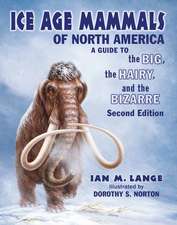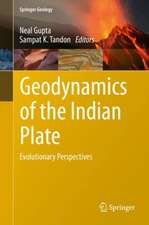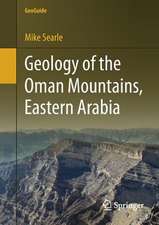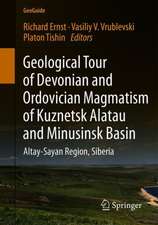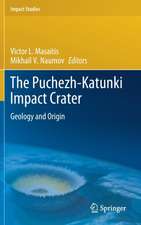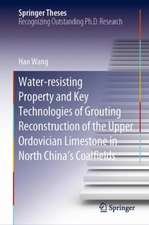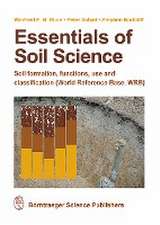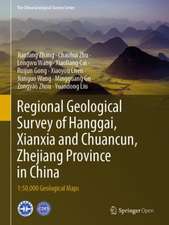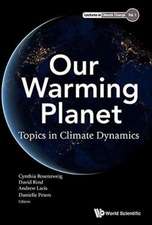The Luxembourg Gutland Landscape
Editat de A. M. Kooijman, L.H. Cammeraat, A.C. Seijmonsbergenen Limba Engleză Hardback – 10 noi 2017
| Toate formatele și edițiile | Preț | Express |
|---|---|---|
| Paperback (1) | 565.13 lei 38-44 zile | |
| Springer International Publishing – 31 aug 2018 | 565.13 lei 38-44 zile | |
| Hardback (1) | 906.33 lei 3-5 săpt. | |
| Springer International Publishing – 10 noi 2017 | 906.33 lei 3-5 săpt. |
Preț: 906.33 lei
Preț vechi: 1105.28 lei
-18% Nou
Puncte Express: 1359
Preț estimativ în valută:
173.42€ • 181.56$ • 143.50£
173.42€ • 181.56$ • 143.50£
Carte disponibilă
Livrare economică 15-29 martie
Preluare comenzi: 021 569.72.76
Specificații
ISBN-13: 9783319655413
ISBN-10: 3319655418
Pagini: 276
Ilustrații: IX, 276 p. 142 illus., 104 illus. in color.
Dimensiuni: 178 x 254 mm
Greutate: 0.89 kg
Ediția:1st ed. 2018
Editura: Springer International Publishing
Colecția Springer
Locul publicării:Cham, Switzerland
ISBN-10: 3319655418
Pagini: 276
Ilustrații: IX, 276 p. 142 illus., 104 illus. in color.
Dimensiuni: 178 x 254 mm
Greutate: 0.89 kg
Ediția:1st ed. 2018
Editura: Springer International Publishing
Colecția Springer
Locul publicării:Cham, Switzerland
Cuprins
Chapter 1. Geological Evolution of Luxembourg and Its Cuesta Landscape.- Chapter 2. Historical Perspective of Dutch Geomorphological Research in the Gutland region in Luxembourg.- Chapter 3. Palynological Reconstruction of the Effects of Holocene Climatic Oscillations and Agricultural History on Soils and Landforms in Luxembourg.- Chapter 4. Contrasting Hydrologic Response in the Cuesta Landscapes of Luxembourg.- Chapter 5. Hybrid Geomorphological Mapping in the Cuesta Landscape of Luxembourg.- Chapter 6. Soils of the Luxembourg Lias Cuesta Landscape.- Chapter 7. Alternative Strategies for Nutrient Cycling in Acidic and Calcareous Forests in the Luxembourg Cuesta Landscape.- Chapter 8. Relationships Between Forest Vegetation, Parent Material and Soil Development in the Luxembourg Cuesta Landscape.- Chapter 9.- Steinmergelkeuper Forest Soils in Luxembourg: Properties and Pedogenesis of Soils with an Abrupt Textural Contrast.- Chapter 10. Soil Animals and Litter Quality as Key Factors toPlant Species Richness, Topsoil Development and Hydrology in Forests on Decalcified Marl.- Chapter 11. Applications of Physiotope Mapping in the Cuesta Landscape of Luxembourg.- Chapter 12. Twenty Five Years of Life Lessons.
Notă biografică
Annemieke Kooijman received her PhD in Biology in 1993 at the University of Utrecht on changes in nutrient availability and vegetation in rich fens due to environmental stress. She has been working at the University of Amsterdam as a landscape ecologist, currently at the Ecosystem and Landscape Dynamics Department of the Institute for Biodiversity and Ecosystem Dynamics at the University of Amsterdam, The Netherlands. She works on interactions between soils and biota in ecosystems with gradients in geology and pH, such as semi-terrestrial wetlands, coastal dune grasslands and Luxembourg forests, with particular focus on ecosystem nutrition. For the Luxembourg forests, she has published a number of studies about the impact of geology and litter quality on ecosystem functioning. She has been teaching (field) courses on soils and landscape ecology in various ecosystems for more than 25 years.
Erik LH Cammeraat received his PhD in Environmental Sciences in 1992 at theUniversity of Amsterdam on work in hydro-geomorphological processes in a forested marl catchment in Luxembourg. He worked next as a postdoc and PI on EU- and Dutch-funded projects related to Mediterranean desertification and degradation remediation. Currently he is appointed as Associate professor in geomorphology and land degradation at the Ecosystem and Landscape Dynamics Department of the Institute for Biodiversity and Ecosystem Dynamics at the University of Amsterdam, The Netherlands. He works on soil-geomorphology-vegetation interactions in both humid and dryland areas, as well as on degradation remediation strategies using ecoengineering approaches, and on the fate of carbon in soils. He has been teaching (field) courses on geomorphology, soils, landscape ecology, and hydrology for more than 20 years.
Harry Seijmonsbergen was born in 1961 in Amsterdam (The Netherlands) and studied Physical Geography at the University of Amsterdam. During his Master-and PhD research he developed methods for the evaluation of natural hazards based on detailed geomorphological mapping in Austria. He has over thirty years of experience in teaching field courses, remote sensing and GIS tools and techniques.
Currently his research in the Theoretical Computational Geo-Ecology group at the University of Amsterdam is focusing on the functioning of Geo-Ecosystems by analyzing the 3D structure of both the landscape and the vegetation cover using air-born and terrestrial LiDAR-based high resolution elevation data as well as geodiversity mapping at multiple scales.
Textul de pe ultima copertă
This book gathers older and current knowledge of the evolution and functioning of cuesta landscapes to provide a better understanding of the Luxembourgian landscape. The geological variety and tectonic setting of the area provide excellent opportunities to study landscape development, hydrology, geomorphological processes, soil formation, forest vegetation and interrelationships between them, which are characteristic of larger parts of Europe. The book is organized around four themes. The first addresses the development of the Luxembourgian cuesta landscape, covering geological evolution, lithology, geomorphological characteristics and hydrology, as well as the scientific history of research in this area. The second theme addresses aspects of the landscape’s geo-ecological- system functioning and development, including soils, nutrient availability, forest ecology and educational approaches to study geo-ecological systems, including old and modern mapping techniques. The third theme isrelated to biological and physico-chemical control of erosion processes, including the impact of (macro-)fauna, vegetation and substrate on soil erosion processes. The last theme discusses practical applications of the research findings.
Caracteristici
Covers a number of different landscape aspects of the Luxembourg Cuesta Offers detailed geo-ecological field descriptions and accompanying GIS-based maps Focuses on long-term landscape development and short-term surface processes Includes supplementary material: sn.pub/extras

